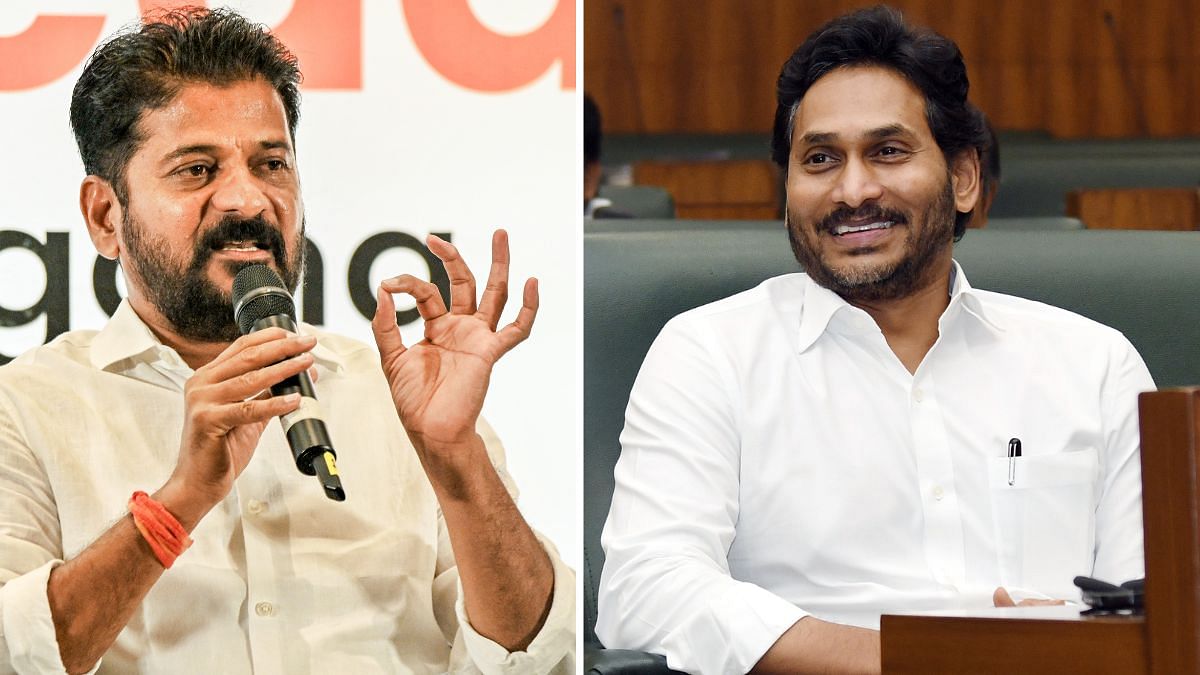The gesture of camaraderie from the Telangana Chief Minister to his counterpart in Andhra Pradesh — whose name will be revealed after the 4 June election results — is significant as the 10th anniversary of the division of the erstwhile Andhra Pradesh into the two successor states of Telangana and Andhra Pradesh is coming up on 2 June.

While the initial resentment post-bifurcation has somewhat diminished, with both governments preoccupied with their respective affairs, disputes over the division of most assets and liabilities of the combined state persist.
Critical unresolved matters, such as the division of assets, urgently require the attention of both state leaders. Among other issues like river waters, the Andhra Pradesh and Telangana governments have to apportion public sector assets to the tune of Rs 1.4 lakh crore — some of them prime properties in Hyderabad.
Moreover, apart from settling a few other matters, such as the distribution of nearly 60,000 employees from the former state and the properties of Andhra Pradesh Bhavan in Delhi, the two states remain at odds over the division of assets belonging to various institutions and corporations.
There is also a lack of agreement on other liabilities, including power dues owed by one state to the other. Andhra Pradesh alleges that Telangana owes it over Rs 7,000 crore for energy supplied between June 2014 and June 2017 — which Telangana has so far refused to clear.
The issue of outstanding power dues from Telangana’s electricity distribution companies has been a persistent concern for Andhra Pradesh Chief Minister Y.S. Jagan Mohan Reddy, who has raised it in numerous meetings with Prime Minister Narendra Modi in New Delhi over the past five years, but to no avail.
Furthermore, both states were mandated to transfer the management and control of irrigation projects on the Krishna and Godavari rivers to the respective river management boards established under the Andhra Pradesh Reorganisation Act, 2014 — a transition that has yet to occur.
Additionally, central paramilitary forces were expected to safeguard the projects spanning both states, yet this responsibility remains largely with the state police.
Amid this uncertainty, dramatic incidents occasionally erupt at border locations, with a notable recent event taking place the night before the Telangana assembly elections on 30 November.
Andhra Pradesh Police teams stormed the massive Nagarjuna Sagar project on river Krishna, taking control of some points, leading to a heated confrontation with Telangana Police. The management of Sagar was earlier given to Telangana, while Srisailan upstream was handed to Andhra Pradesh.
Some observers, however, said the drama was a plot hatched by K. Chandrashekar Rao and Jagan Mohan Reddy regimes to benefit the Bharat Rashtra Samithi (BRS) in the polls by showing “AP highhandedness as a bogey.”
Also Read: Telangana CM faces heat for roping in Oscar-winning Andhra music composer Keeravani for state anthem
Andhra Pradesh goes to court
Unable to resolve the differences, mainly concerning the public sector assets, Andhra Pradesh knocked on the Supreme Court’s door in 2022 complaining that the actual division of assets and liabilities belonging to the combined Andhra Pradesh has not commenced to date. It sought the SC’s intervention to appoint arbitrators under the court’s supervision.
A senior official from Andhra Pradesh told ThePrint that division can happen only by judicial intervention.
“The difference between this division and others that have happened in the past is that the state, which wanted to separate, Telangana in this case, got the capital. In the earlier three states, including Bihar, Madhya Pradesh and Uttar Pradesh, the capital remained with the main state, which did not want separation. So, the new state that got separated was happy and they got rid of the main state. So, asset division was not a very big issue,” the official said.
However, the situation with Andhra Pradesh is different, he said, adding, “There is a lot of bitterness in the separation. AP did not want the state to be divided.”
According to him, Andhra Pradesh wants a retired SC judge to be appointed commissioner/arbitrator to oversee the division of assets between the two states. “Otherwise, division of assets will not happen. Division of such assets can happen if both political governments agree, or it has to be done by the court.”
Meanwhile, a second official from Andhra Pradesh added that Telangana’s concept of division is based on whatever they agree to give. “AP has not accepted it. That is why the matter is before the Supreme Court,” the official said.
The official added that the Ministry of Home Affairs (MHA) since 2016 has called the two states for meetings over 30 times to resolve the differences. However, there has been no breakthrough, except for the division of Andhra Pradesh Bhavan.
“Their (MHA) stand in the meetings is to tell us that you two (AP and Telangana) discuss, agree to a solution and come to us. The two states have met several times. But there has been no agreement. This back and forth has been going on for a long time,” the official highlighted, as the dispute between the two states over much of the physical assets of the combined state continues.
What are AP and Telangana squabbling over
According to the Andhra Pradesh Reorganisation Act, 2014, Hyderabad was declared the common capital of the two successor states for 10 years.
The bone of contention between Andhra Pradesh and Telangana lies in the division of assets of companies, corporations, and institutions as outlined in Schedules IX and X of the Reorganisation Act.
Schedule IX, which deals with apportionment of assets of companies and corporations between the two states, specifies that the assets of headquarters of such undertakings are to be divided based on the population ratio of 58:42 (58 percent to AP and 42 percent to Telangana) and operational assets on location.
In all, there are 89 government companies and corporations listed under Schedule IX whose assets, rights and liabilities have to be apportioned. These include Andhra Pradesh State Civil Supplies Corporation Ltd, Andhra Pradesh Housing Board, and Andhra Pradesh Aviation Corporation Ltd, among others.
Additionally, 142 institutions valued at approximately Rs 40,000 crore listed under Section X — such as the Environment Protection Training and Research Institute and the AP Forest Academy, among others — remain undivided due to ongoing disputes.
Most of these companies and corporations’ headquarters are located in Hyderabad, the capital of the combined state and joint capital of separated states till 2 June.
Meanwhile, the two states have yet to reach a consensus on the definition of headquarters assets, as the term is not explicitly defined in the Act, according to a first official quoted earlier. Moreover, several matters are also under litigation.
A third official told ThePrint that they are not very hopeful of a resolution. “Just look at the history of state division in the country and you will understand what I am saying. States are divided because of politics, and once the division is done, everything else, including distribution of resources is by and large forgotten,” the official said.
There are bitter examples from the bifurcation time too.
For instance, soon after the bifurcation, Telangana captured the office of the National Academy of Construction located in Hyderabad. “Telangana authorities did not let the staff enter the premises. They also captured some other buildings belonging to AP and started running a police station from there,” the third AP official quoted earlier said.
Similarly, the Law Association of Telangana did not allow the combined High Court (HC) to function for a few days in Hyderabad. The HC is now divided with Andhra Pradesh’s principal judiciary running from Amaravati, but for a few years, it was common.
“Regarding the division of judicial employees, the stand taken by Telangana — which was supported by the Lawyers Association of Telangana and Judicial Officers Association — was that no AP officer can come to Telangana. All of them have to remain in AP. The SC had to finally intervene and allocate the judicial officers between the two states,” the official said.
Finally, a committee headed by retired IAS officer Sheela Bhide was appointed in June 2014 to give its recommendation on the division of assets, according to the Andhra Pradesh Reorganisation (APR) Act, 2014. While Andhra Pradesh decided to accept the entire set of recommendations of the Bhide committee, Telangana accepted only a few.
Also Read: Jagan, Naidu & Kalyan’s post-campaign sojourn abroad sparks curiosity in AP’s political circles
How is it impacting AP?
While Telangana has refused to budge from its position, Andhra Pradesh officials said the bifurcation cost them greatly.
“It was a very ad hoc kind of bifurcation and was done purely for political reasons,” the second AP official said.
The official added that most of the assets were not available with Andhra Pradesh. “In some instances, accounts of corporations and institutions have been frozen by Telangana,” the official added.
According to officials, Andhra Pradesh is at the receiving end because, in the erstwhile Andhra, all capital-centric development took place in Hyderabad — which became the nerve centre of the combined state.
“All the institutions and assets were created in or around Hyderabad. Hardly anything was outside. So, if the formula of dividing assets according to location is applied, everything goes to Telangana. More than 90 percent of assets are in Telangana,” a fourth AP official said.
The official highlighted that the crucial aspect is Hyderabad.
“Hyderabad contributes hugely to the state’s GDP. So, that much revenue you lose. What the Centre did was they appointed a 15th Finance Commission headed by Dr Y.V. Reddy, who looked into these things. The FC identified the deficit of AP and tried to compensate. But AP said that it is not an accurate compensation. The loss suffered by Andhra is far higher than what was actually given,” the official said.
After the 15th FC, the 16th FC also gave a revenue deficit grant to Andhra Pradesh. “But it was not enough. So, the deficit continues,” the official added.
Meanwhile, in response to Andhra Pradesh’s contentions, a top bureaucrat in Telangana said that the new government under Revanth Reddy was willing to negotiate and settle the assets and dues, including the power sector.
“Our CM’s direction is for an amicable solution, especially in the case of long contentious matters. As evident, the settlement of the AP Bhavan property in Delhi could happen within weeks as our CM took a cooperative approach. He wishes to extend the same mutually agreeable approach for speedy division of all the assets,” the official told ThePrint.
However, another senior Telangana official admitted to their opposition to the Sheela Bhide report. “We disapproved the recommendations on the division of some assets. AP went to the Supreme Court on the assets apportioning issue. But we are willing to take a considered view. Of course, a lot depends on who will come to power in AP next,” the official remarked.
The power dues issue could also be settled soon, if required, keeping the contentious accumulated interest matter aside, the official added.
Following the general election in Telangana, Revanth convened a cabinet meeting to discuss bifurcation-related issues, among other topics. However, the Election Commission of India’s disapproval, pending the Model Code of Conduct, delayed the discussions.
“We will take the matter up in the next cabinet meeting post results to arrive at a feasible approach with AP on the issues evading consensus so far,” said the Telangana official.
The CM had earlier directed all departments to compile detailed reports on bifurcation-related issues, including a list of assets and buildings to be taken over from Andhra Pradesh. These properties include the prominent Lake View Guest House in Hyderabad.
(Edited by Richa Mishra)
Also Read: Does breaking up big states boost economy? Data doesn’t back up hype, says Indian study

